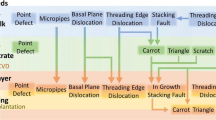Abstract
Various types of radiation in hostile environments cause transient and permanent changes in the devices used in complex integrated circuits. The failure of a particular IC is a function not only of the basic material and device parameter changes but also of the circuit environment in which the device is located. Circuit techniques have been developed which minimize the detrimental effects of radiation on certain types of circuits. In other cases, circuit techniques are not very effective in minimizing radiation effects. This work discusses selected issues related to the interactions between device radiation effects and circuit performance or circuit failure in a hostile radiation environment. This is not meant to be a comprehensive study of circuit effects but rather several examples are selected to illustrate the issues involved in designing circuits to operate in hostile radiation environments.
Similar content being viewed by others
References
E. G. Stassinopoulos and J. P. Raymond, Proc. IEEE76, 1423(1988).
J. R. Srour and J. M. McGarrity, Proc. IEEE76,1443 (1988).
S. E. Kerns and B. D. Shafer, Proc. IEEE76, 1470 (1988).
R. L. Pease, A. H. Johnston and J. L. Azarewicz, Proc. IEEE76, 1510 (1988).
R. D. Rasmussen, Proc. IEEE76, 1527 (1988).
B. L. Gregory, “Radiation Defects in Devices”,1972 Defects in Semiconductors, paper 36, Conf. Proc., Reading, England.
L. Pease, R. M. Turfler, D. Platteter, D. Emily and R. Blice, IEEE Trans. Nucl. Sci.NS-30, 4216 (1983).
J. T. Blandford, Jr., A. E. Waskiewicz and J. C. Pickel, IEEE Trans. Nucl. Sci. 31, 1568 (1984).
J. C. Pickel, J. T. Blandford Jr., A. E. Waskiewicz and V. H. Strahan, Jr.,IEEE Trans. Nucl. Sci. 32, 4176 (1985).
A. E. Waskiewicz, J. W. Groninger, V. H. Strahan and D. M. Long, IEEE Trans. Nucl. Sci. 33, 1710 (1986).
J. R. Srour, R. A. Hartmann and K. S. Kitazaki, IEEE Trans. Nucl. Sci. 33, 1597 (1986).
R. Zuleeg, “Radiation Effects of GaAs Integrated Circuits,” in VLSI Electronics: Microstructure Science, vol. 11, GaAs Microelectronics, N. G. Einspruch and W. R. Wisseman, eds.New York, NY: Academic Press, pp. 391–437 (1985).
T. R. Oldham and J. M. McGarrity, IEEE Trans. Nucl. Sci.NS-28, 3975 (1981);NS-30, 4377 (1983).
C. W. Perkins, Appl. Phys. Lett.12, 153 (1968).
P. S. Winokur, H. E. Boesch, Jr, J. M. McGarrity and F. B. McLean, IEEE Trans. Nucl. Sci.NS-24, 2113 (1977).
J. R. Schwank and W. R. Dawes, IEEE Trans. Nucl. Sci.NS-30, 4100 (1983).
J. R. Schwank, P. S. Winokur, P. J. McWhorter, F. W. Sexton, P. V. Dressendorfer and D. C. Turpin, IEEE Trans. Nucl. Sci.NS-31, 1434 (1984).
J. P. Mitchell, IEEE Trans. Elec. Dev.ED-14, 764 (1967).
H. L. Hughes, “A Survey of Radiation-Induced Perturbations in Metal-Insulator-Semiconductor Structures,”9th Annual Proc., Reliability Physics,33 (197).
P. V. Dressendorfer, J. M. Soden, J. J. Hurrington and T. V. Nordstrom, IEEE Trans. Nucl. Sci.NS-28, 4281 (1981).
T. R. Oldham, A. J. Lelis, H. E. Boesh, J. M. Benedetto, F. B. McLean and J. M. McGarrity, IEEE Trans. Nucl. Sci.NS-34, 1184 (1987).
G. F. Derbenwick and B. L. Gregory, IEEE Trans. Nucl. Sci.NS-22, 2208 (1975).
B. L. Bhuva, “The Simulation of Worst-Case Operating Conditions for Integrated Circuits Operating in a Total Dose Environment,” Ph.D. Thesis, N.C. State Univ. (1987).
Augmented version of curve originally published in E. L. Petersen, J. B. Langworthy and S. E. Diehl, IEEE Trans. Nucl. Sci.NS-30, 4533 (1983).
F. Larin,Radiation Effects in Semiconductor Devices, John Wiley & Sons, New York, NY (1968).
H. H. Sender and B. L. Gregory, IEEE Trans. Nucl. Sci.NS-13, (1966).
R. L. Pease, R. M. Turfler, D. Platteter, D. Emily and R.Blice, IEEE Trans. Nucl. Sci.NS-30, 4216 (1983).
R. Zuleeg, J. K. Notthoff and D. K. Nichols, IEEE Trans. Nucl. Sci.NS-31, 1121 (1984).
T. R. Weatherford, J. R. Hauser and S. E. Diehl, IEEE Trans. Nucl. Sci.NS-33, 1590 (1986).
L. W. Massengill, S. E. Diehl-Nagle and T. F. Wrobel, IEEE Trans. Nucl. Sci.NS-32, 4026 (1985).
L. W. Massengill, “The Simulation of Pulsed-Ionizing-Radiation-Induced Errors in CMOS Memory Circuits,” Ph.D. Thesis, N.C. State Univ. (1987).
Author information
Authors and Affiliations
Rights and permissions
About this article
Cite this article
Hauser, J.R., Kerns, S.E. Circuit related issues due to radiation in hostile environments. J. Electron. Mater. 19, 671–688 (1990). https://doi.org/10.1007/BF02655236
Received:
Revised:
Issue Date:
DOI: https://doi.org/10.1007/BF02655236




